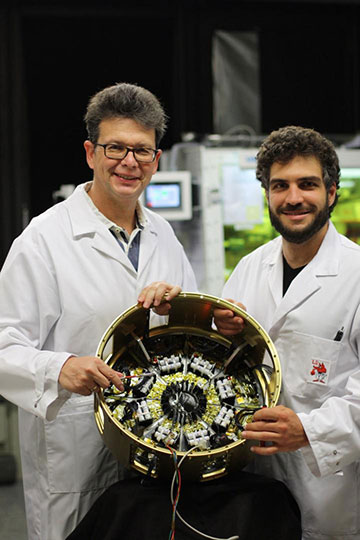![]()
The rocket launched with the solar-cell experiment aboard in the course of the MAPHEUS 8 campaign in Kiruna, Sweden in June 2019. [Image: DLR MORABA]
Silicon solar panels have been used on spacecraft since 1959, and their power-conversion efficiencies have increased substantially in the years since. But expanding the use of solar technology for aerospace applications will require improving not just efficiency, but “specific power”—the ratio of power to weight. And traditional solar cells in space today are heavy and bulky, limiting this metric.
One approach for boosting specific power is to use the emerging, lightweight technologies of perovskite and organic photovoltaics in space, the respective efficiencies of which have climbed to around 25% and 17% in terrestrial applications in recent years. But an in-space demonstration of these technologies had been lacking. Now, researchers in Germany have launched these promising solar cells into space on a suborbital rocket flight—tracking their efficiencies and confirming their functionality under hazardous space conditions (Joule, doi: 10.1016/j.joule.2020.07.004).
Improving specific power
To improve specific power and minimize the rocket’s weight—especially important during launch—it’s key to bring down the weight of solar cells, which is why thin, lightweight and flexible hybrid perovskite and organic photovoltaics (HOPVs) are driving interest for space applications. What’s more, HOPVs are also much easier to manufacture than their inorganic counterparts.
Peter Müller-Buschbaum, Professor of Functional Materials at the Technical University of Munich, Germany, senior author of the current study, says that these attractive characteristics make perovskte and organic solar cells “perfect alternative candidates for the future fabrication of solar panels.” The sub-micron-thick cells can be processed onto thin polymer foils to cover an impressive surface area and enable a high specific power.
However, until June of last year, these solar cells had not been tested under space conditions. Müller-Buschbaum and his team conducted intensive performance tests under simulated space conditions (ACS Appl. Mater. Interfaces, doi: 10.1021/am504608p) in 2014, followed by balloon flights. The clear next step was to launch the solar cells into space.
Ready for liftoff

Peter Müller-Buschbaum (left) and Lennart Reb (right) of TUM holding the experiment “Organic and Hybrid Solar Cells In Space” (OHSCIS). [Image: Wei Chen, Chair of Functional Materials, Technical University of Munich]
The team arranged four solar-cell module types—two perovskite and two organic—onto the cylindrical payload of the rocket MAPHEUS-8; four of each type of cell was included, totaling 16 individual cells. These four module types represented a simplified selection of state-of-the-art single-junction perovskite and organic architectures and absorber materials, Müller-Buschbaum says.
The rocket reached an altitude of 240 km, which is within low-Earth orbit altitudes. In addition to demonstrating efficiency, the HOPVs proved their stability under strong solar irradiation, micro-gravity, ultra-high vacuum and significant temperature differences.
Although the flight only lasted seven minutes, the team was able to continuously record the current–voltage characteristics of the solar cells and confirm that each type reached its expected performance. The power densities of the cells ranged from 7 to 14 mW cm−2, which according to Müller-Buschbaum, outperforms the existing solid-state solar-cell technologies. He also expects that higher values will be possible with further optimization of the technology.
In addition to tracking those efficiencies, the team was able to confirm that the cells also function in low-light conditions, meaning that even the cells facing away from the Sun generated energy. These cells absorbed the weak, diffuse light reflecting up from the Earth’s surface even when not exposed to direct sunlight. According to Müller-Buschbaum, these results indicate that the cells could be useful in deep-space missions.
An eye to the sky
The power densities demonstrated in this study, says Müller-Buschbaum, will enable a broader use of perovskite and organic solar cells in future space exploration. “Moreover, their flexibility will enable completely new solar module designs, since flexible solar panels can be rolled-up or folded,” he explains. “Apart from an extensive potential to save weight and costs or introduce new designs, perovskite and organic solar cells create the opportunity for novel possibilities of space-mission design, such as solar-powered deep-space missions and efficient electric propulsion.”
One limit of the current study, he says, is the rocket’s limited flight time. Moving forward, the team is interested in long-term trials in space, such as with satellites, to get a better feel for the technology’s durability and stability.
